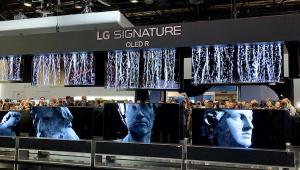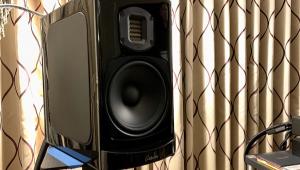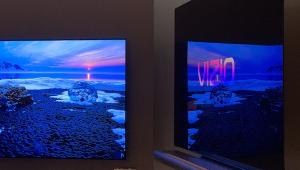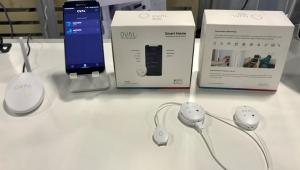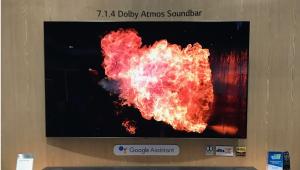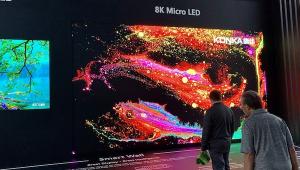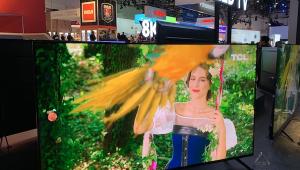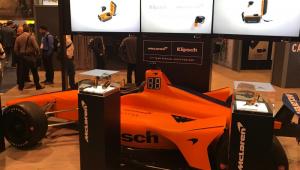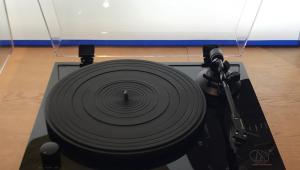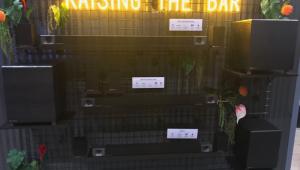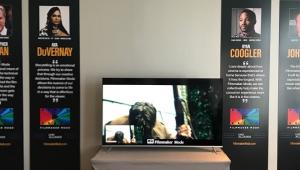Hisense Touts Performance with Dual Cell LCD and Quantum Dots
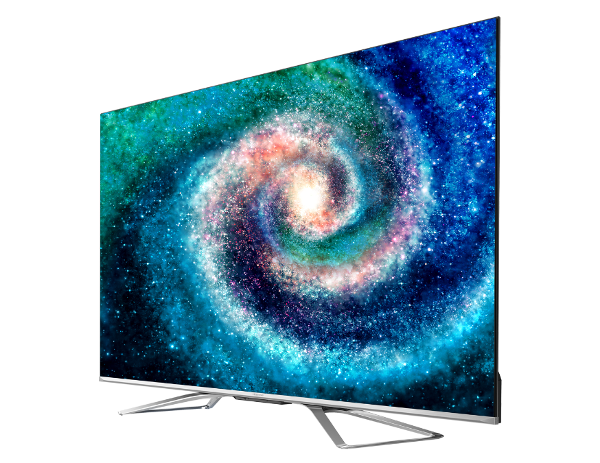
Hisense’s proprietary Dual Cell technology delivers OLED-rivaling blacks and greater-than-OLED peak luminance at price points lower than comparably sized OLED TVs, the company said. Dual Cell appears in a 4K TV due in the third quarter and two 8K TVs, among multiple 8K models that might ship in the second half.
In expanding its quantum-dot selection, Hisense is bringing the technology to a new entry-level ULED series (H8G Quantum), with opening prices of $399 for 50 inches and $499 for 55 inches, down from a 2019 opening price of $599 for 55 inches. All prices are MSRPs.
In other technology advances, the company:
• Unveiled its first TVs with built-in far-field microphones, appearing in seven 4K Android TVs to deliver voice control of TV functions and built-in Google Assistant. They also come with mic-equipped remotes.
• Expanded its selection of TVs with Dolby Vision dynamic HDR (high dynamic range) and Dolby Atmos object-based surround, with Atmos spreading from two models last year to 12 models, all featuring Hisense’s Premium ULED or ULED suite of technologies.
• Bolstered its selection of 65- and 75-inch 4K models, launching six 65-inch TVs, three 75-inch TVs, and its first 85-inch TV for the U.S. market.
• Introduced its first 4K TVs with HDR 10+ dynamic HDR, which is paired with all 4K TVs incorporating Hisense’s ULED or Premium ULED suite of technologies. All 4K models also feature HLG.
• Unveiled its first six TVs with DTS Virtual:X post processing, all in the 4K H65G series, to deliver surround and height effects through the TVs’ embedded speaker pair from two-channel, multichannel, and object-based multichannel soundtracks.
To give customers a choice of smart-TV platforms, Hisense widened its selection of smart TVs running the Android TV OS while continuing to offer Roku TVs. Hisense also offers its proprietary Vidaa smart-TV platform in the current “Laser TV” line of ultra-short-throw projectors.
Hisense is “increasing its focus on quality and performance,” said James Ninesling, head of product marketing. “We’re bringing out more premium products at really competitive price points.” In another shift, the company two years ago launched U.S.-based R&D operations so U.S. marketers could take the lead in developing products specifically for U.S. consumers, he told Sound & Vision.
The company enjoys “among the lowest defect and return rates” in the U.S., Ninesling also claimed.
Here’s what Hisense unveiled at CES in a bid to deliver on its promises:
Dual Cell LCD: Hisense is the first company offering Dual Cell LCD technology, which is said to produce OLED-rivaling blacks and greater-than-OLED peak luminance at price points lower than comparably sized OLED TVs.
The technology appears in the 65-inch 4K ULED XD9G (pictured) and in a working sample of an 8K TV. The 4K model will be the company’s flagship 4K TV when it becomes available in the third quarter. The 8K model is among multiple 8K TVs that Hisense is showing and might decide to offer in the second half. Pricing wasn’t announced.
Hisense launched the world’s first Dual Cell TV in China in 2019, and the model at CES delivers higher performance, Ninesling said. Though pricing wasn’t announced, the XD9G will cost hundreds of dollars less than the expected third-quarter price of 65-inch OLEDs at $2,000 to $2,299, he said.
Dual-cell TVs bond a 2K luminance LCD panel to a 4K color LCD panel, with the 2K panel modulating white-light levels reaching the 4K panel. The technology effectively creates 2 million back-lit local dimming zones, controlling light at the pixel level, Ninesling said.
The technology delivers a 100x improvement in contrast compared to a single-cell LCD “because the two panels multiply their contrast levels,” added Jeff Yurek, marketing director of Nanosys, whose color-gamut-widening quantum-dot technology is used in the TV. “You can have a 1,000-nit pixel right next to a jet-black pixel, so there’s an extra level of wow-factor that you don’t get with OLED.”
Although the black levels of dual-cell LCD TVs are not technically “zero” like OLED blacks, Yurek noted, “they are so close to zero that your eye can’t really tell the difference.”
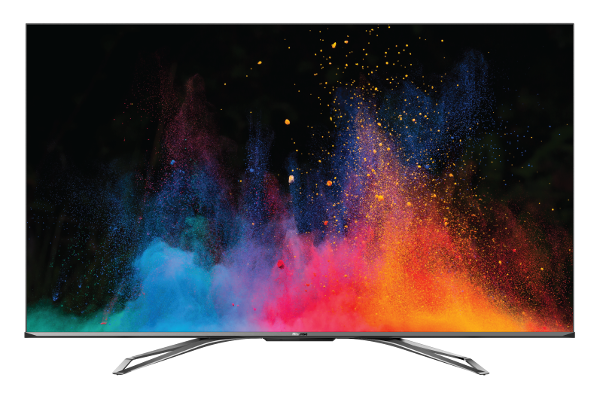
The XD9G features Hisense’s Premium ULED suite of technologies, a step up from the standard ULED suite. Standard ULED TVs feature a minimum of 700-nit peak brightness, back-lit full-array local dimming (FALD) zones, Dolby Vision HDR, Dolby Atmos surround sound, a native 60-Hz panel, and Hisense’s Hi-View processor. Models with the Premium ULED designation step up to a minimum 1,000 nits, more dimming zones, a native 120-Hz panel, and an improved Hi-View engine.
Other XD9G features include Android TV OS, a quantum-dot panel, peak brightness of more than 1,000 nits, HDR10+ HDR, built-in Google Assistant, and a built-in far-field mic along with a mic-equipped remote.
Laser TV: Hisense is making its Laser TV line of ultra-short-throw projectors more affordable with the launch of the 100-inch L5, arriving in April and bringing down the opening price of the line from $10,000 to $5,999. It’s the first Laser TV projector with Android TV OS, complementing current 100- and 120-inch models that use Hisense’s proprietary Vidaa smart-TV OS.
Like the current Laser TV projectors, the L5 includes a TV tuner and built-in speakers packaged with an ambient-light-rejecting projection screen. The current two Laser TV models use a combination of red and blue lasers to widen color gamut to greater than 95% of the P3 standard, but the new model features a blue laser only. It achieves a brightness level of 2,600 lumens compared with 3,000 lumens for the current models.
At $5,999 or $10,000, Hisense said its Laser TV projectors not only cost tens of thousands of dollars less than a 100-inch 4K flat-panel LCD TV but are more energy-efficient, lighter, and easier to bring into and move around the house.
4K H9G Quantum Series: Like the 65-inch Dual Cell XD9G, the 55- and 65-inch models in the 4K H9G Quantum series feature the Premium ULED suite of performance standards, including peak brightness of more than 1,000 nits, a native 120-Hz screen, Dolby Vision HDR, and Dolby Atmos surround sound. Both TVs also feature an Android TV OS, a quantum-dot display, HDR10+, a far-field mic for hands-free voice control of TV functions and the built-in Google Assistant, and more back-lit full-array local dimming (FALD) zones than their predecessors: 132 zones in the $699 55-inch model and 180 zones in the $999 65-inch model &mdash both due out in April.
4K H8G Quantum: Gamut-widening quantum-dot panels will start at $399 in the 2020 lineup, down from $599, with the H8G Quantum series of four Android TVs, which is due out in March.
Screen sizes are 50, 55, 65 and 75 inches at respective prices of $399, $499, $699, and $1,399. Features include the standard ULED-technology suite, HDR10+, built-in Google Assistant, and a remote with built-in voice-control mic.
4K R8F Roku TVs: The company brought ULED technology to 4K Roku TVs for the first time in December with the shipment of 55- and 65-inch R8F TVs at respective prices of $499 and $699.
Both lack quantum dots but include the standard ULED technology suite plus Dolby Vision HDR and Dolby Atmos surround sound. They also add HDR10+ HDR and control via a Google Assistant or Alexa smart speaker. Both feature peak brightness of 700 nits with 56 and 60 local dimming zones, respectively.
Android TV versions of these models are already available with ULED at the same sizes and prices.
4K H65G Android TVs: The company is expanding its Android TV lineup and expanding into lower price points with the 4K H65G series, featuring six screen sizes from 43 to 85 inches, and the 1080p H55G series with three models from 32 to 43 inches. The company said it will have more Android TVs than its competitors in 2020.
The 4K series TVs lack ULED but include Dolby Vision HDR, DTS Virtual:X post processing, built-in Google Assistant, and voice control via a remote with an embedded mic. Prices are $269 for a 43-inch screen, $299 (50 inch), $329 (55 inch), $479 (65 inch), $899 (75 inch), and $1,499 (85 inch).
The 1080p series consists of 33-, 40-, and 43-inch screens at a respective $139, $199, and $229.The 1080p and 4K series will be available in the third quarter.
4K R7, R6 Roku TVs: The company is offering Roku TVs in more screen sizes and price points with the launch of the 4K R7 and 4K R6 series and the 1080p H4 series.
The four 4K R7 models lack ULED but feature a wide color gamut, though Hisense didn’t say how wide. They also feature voice remote to control TV functions and voice control via Google Assistant and Amazon Alexa smart speakers. The 43-, 50-, 55-, and 65-inch models will be available in the third quarter at respective prices of $249, $299, $349, and $499.
The 4K R6 series will be available in March in five screen sizes from 43 to 75 inches. Prices were unavailable. The 1080p H4 series comprises three size from 32 to 43 inches at $115 to $196.
